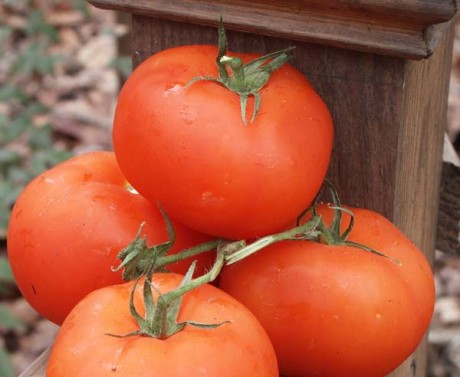Two-Minute Tomatology
Plus garden to do’s for June & July
By L.A. Jackson
There are two kinds of tomato varieties: hybrid and non-hybrid. Hybrids like 'Early Girl', 'Better Boy' and 'Whopper' have been top choices with Carolina Country gardeners because of their vigor and productivity. However, many hybrids have come under fire from tomato purists for not having full flavor.
Non-hybrid tomatoes, which includes heirlooms such as the well-liked 'Cherokee Purple', 'German Johnson' and 'Mortgage Lifter', generally have great taste, but tend to be less resistant to many common tomato problems (although there are exceptions). Non-hybrids have another advantage: Their seeds can be saved to produce another crop next year.
Tomato varieties can also be either "indeterminate" or "determinate." Indeterminates are the tomatoes typically grown by most gardeners today. Once the plants start producing, they can bear tomatoes into the early fall, if kept healthy.
Determinate tomatoes develop almost all of their fruit over a short period of time. They also are normally restrained in height, which is desirable for small veggie patches and patio gardens. Popular determinate selections include the heirloom 'Marglobe' and the hybrid 'Celebrity'.
One more thing to look for in a tomato variety is resistance to four particular nasties that can mess up a 'mater patch: Fusarium wilt, verticillum wilt, nematodes and tobacco mosaic. Fortunately, there are varieties that resist some or all of these garden troubles. If the labels on the plants or seeds have the letters "F," "V," "N" and/or "T" on them, that means the varieties are less susceptible to these problems.
Garden To-Do's
June
- Pick the spent flowers of such annual ornamentals as marigolds, petunias, salvias and zinnias to encourage even more blooms.
- Prevent bitter cucumbers by putting the plants on a regular watering schedule if the rains don't come and mulching them heavily.
- Herbs are usually at their harvesting best just before flowering when they contain the maximum in essential oils.
- Now is a great time to add a few tropical water lilies to the backyard pond. Don't forget to include fertilizer in each pot, as these heavy-feeders need the nutrients for maximum flower production.
- If you weed by hand, remember the best way to prevent even more weeds is to pull the pesky plants before they develop seed heads. Also, right after a soaking rain is the easiest time to pull them up with their roots intact.
July
- Cut your lawn's grass when it is dry, not wet. This will not only help prevent soil compaction and turf injury, but it will also lessen the spread of grass diseases.
- Grass suddenly die? It might not be from lack of water. Dig into the dead area to check for signs of underground grub infestation.
- Pick vegetables such as beans, okra, squash, peppers, cucumbers and indeterminate tomatoes on a regular basis to encourage the plants to produce even more.
- If hot weather is melting holes in the flower border, replant with such heat-loving annuals as celosias, marigolds, periwinkle, portulaca, salvias and zinnias.
-
Share this story:


